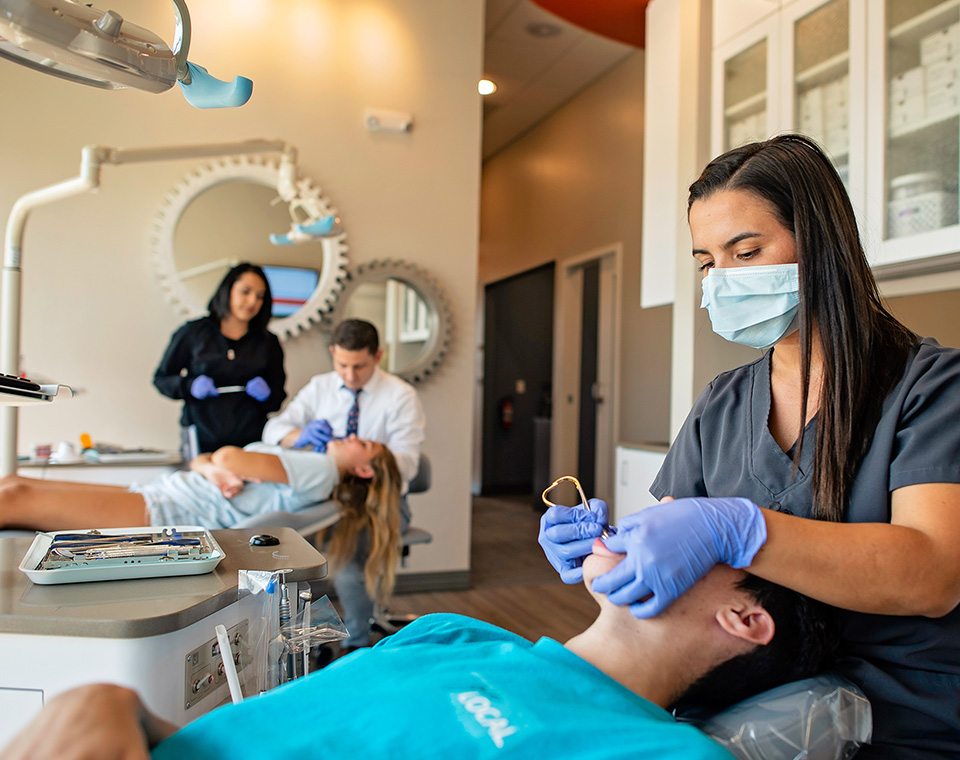Is It Possible to Wear Braces Even With Wisdom Teeth?

Orthodontic care and wisdom teeth do not get along. But we should think about that statement twice. And yes, the development of wisdom teeth, in general, presupposes a concern, but despite their evilness, -you can still have your orthodontic treatment with them in place-.
And no, we are not saying you shouldn’t keep an eye on wisdom teeth while having treatment with braces, as every case differs in severity and particularities. We mean that, in many cases, you can have your braces on even during the eruption of wisdom teeth while on braces treatment.
In other cases, however, you might have “impacted” wisdom teeth. This typology refers to teeth stuck below the gum surface and growing at an awkward angle. Consequently, depending on your dentist’s evaluation, you might be a candidate for wisdom tooth extractions.
We invite you to keep reading this interesting article in which we provide feedback on two common patient concerns. First, is it possible to have orthodontic braces if you have wisdom teeth? Secondly, what would occur if wisdom molar teeth started sprouting during treatment?
Can You Get Braces With Wisdom Teeth?
Yes, you can get Enid braces with wisdom teeth. In fact, in many cases, experienced orthodontists in some cases cement braces in third molars (wisdom teeth). However, to clarify this statement, we refer to a familiar situation:
What happens if an orthodontist diagnoses a patient with malocclusion and she also has her wisdom teeth on the way (sprouting)?
At this point, an expert orthodontist evaluates several factors, like the need to make room to move your molars or if the patient suffers from overcrowding. After that, the extraction of wisdom teeth might be the first action to start solving the problem.
From a dental care perspective, however, an evaluation might reveal a case of pericoronitis produced as an effect of a partially impacted wisdom tooth sprouting combined with poor oral hygiene. In both cases, extraction surgery is the recommended option.
However, there are also cases in which wisdom teeth do not presuppose an orthodontic obstacle, a dental health problem, or a hygiene factor that could cause future inconveniences.
For a clearer picture, wisdom teeth might turn problematic or not. Here we define wisdom teeth cases and their potential associated problems, from the most to the minor complexity regarding the issues they cause and the possible need for extraction.
Mesial Impacted Teeth
Impacted teeth come in different forms. Mesial Impaction is the most common typology and is characterized by its angular position towards the next tooth, named the second molar.
Mesial-impacted teeth erupt partially, meaning there is not enough space to erupt entirely from the gums. As a result, part of the occlusal portion of the tooth hides below the gums while the other is above the gums but forms an angle.
A common problem associated with mesial impacted teeth is pericoronitis. A flap of gum tissue forms on top of the visible part of the mesial-impacted tooth covering the crown.
Food particles accumulate between the soft tissue flap and the tooth crown, making it almost impossible to reach with the toothbrush. This creates the perfect environment for anaerobic bacteria to breed and grow, producing infections.
A recurring option to cure the symptoms is to extract the third molar (wisdom tooth) or cut the flap over the tooth. But, unfortunately, this is not the only issue with a mesial-impacted tooth.
A patient’s wisdom teeth might develop a cavity that could spread to the neighboring tooth. Also, a mesial-wisdom tooth might push against the second molar damaging it.
Horizontal Impaction
As its name implies, a horizontally impacted tooth is flat, with the occlusal portion facing toward the second molar. A horizontally impacted wisdom tooth is entirely below the gums, with no tooth surface above the gums.
Horizontally impacted wisdom teeth are the second most problematic typology. It might be hard to imagine this, but let’s picture this image. Teeth constantly try to erupt, with the occlusal part always directing to the front, trying to reach its final resting position. However, if a tooth moves horizontally below the gums, it will eventually get a second molar affecting it.
In other words, the third molar will continue its misguided way and eventually push into the root of the second molar damaging it.
Distal Impaction
A distal impacted tooth is rare, although it shares some commonalities with mesial-impacted teeth. The tooth sprouts angled and partially. However, the difference lies in the angle’s direction towards the mouth’s rear part.
Vertical Impaction
A vertically Impacted tooth has a correct position with the occlusal portion of teeth facing its counterpart, on the contrary, dental arch. So we started saying orthodontists might leave wisdom teeth in place during orthodontic treatment, and this is the least problematic typology of wisdom teeth. Sometimes they might even place brackets on these teeth.
What Happens if I Have Braces and My Wisdom Teeth Are Coming In?
From an orthodontist’s perspective, the specialist will evaluate the feasibility of leaving it or the need to extract it according to the factors we previously noted. Other characteristics related to the state of the teeth and how it might affect the treatment outcome.
Wisdom teeth might damage other teeth and produce cysts, decay, and gum disease. Despite these considerations, they enter into the realm of dentistry, and an orthodontist might anticipate a negative outcome. Consequently, depending on the teeth’ impaction might recommend extraction with braces, or in other words, detaching the brackets or wires if cemented on wisdom teeth before extracting them.
Does Wisdom Teeth Misalign Other Teeth?
No, impacted or partially impacted wisdom teeth do not misalign other teeth. This is because wisdom teeth don’t have enough strength to produce a displacement of other teeth.
However, after reading this article, you might feel tempted to think orthodontists refer patients to an oral surgeon for wisdom teeth extraction because they misalign teeth. The orthodontist
Planning for Outstanding Results
A successful orthodontic treatment comprises a great deal of planning and anticipation of issues like existing, developing, and sprouting wisdom teeth with a meticulous analysis of its affection during treatment.
At Rose Rock Orthodontics, we invite our dear readers to start the journey to a “planned” beautiful smile that will be the joy of your family, peers, and close ones, but mainly, it will make you smile confidently.


